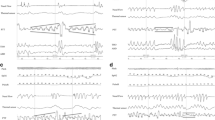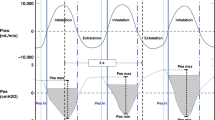Abstract
Objective.Upper airway obstruction is the most rapid and clinically relevant cause of hypoxia during sedation and anesthesia. This study was designed to determine if respiratory inductance plethysmography (RIP) could quantify the degree of upper airway obstruction caused by induction of general anesthesia. Methods.RIP tracings were obtained during induction of general anesthesia in healthy children. Three sets of measurements were obtained during: (1) a 3 minute control period without anesthetics, (2) 3 minutes of 50% nitrous oxide, and (3) halothane administration to complete the induction of general anesthesia. Clinical impression of upper airway obstruction (none, partial, or complete) was correlated with two separate RIP analysis techniques. Results.Three hundred ninety-five breathing epochs from 20 children (ages 3–10 years) were analyzed by both phase shift and phase inversion techniques. Although both techniques had good general correlation with severity of airway obstruction, neither was sufficiently reliable for accurate prediction of severity of airway obstruction. Conclusions.We investigated two methods for analyzing RIP tracings during varying degrees of upper airway obstruction in anesthetized children. We found that neither technique was sufficiently accurate for predicting the severity of upper airway obstruction and would not be useful as a predictor of upper airway obstruction in the clinical or research settings.
Similar content being viewed by others
REFERENCES
Litman RS, Hayes JL, Basco MG, Schwartz AR, Bailey PL, Ward DS. Use of dynamic negative airway pressure (DNAP) to assess sedative-induced upper airway obstruction. Anesthesiology 2002; 96: 342-345
Smith PL, Wise RA, Gold AR, Schwartz AR, Permutt S. Upper airway pressure flow relationships in obstructive sleep apnea. J Appl Physiol 1988; 64: 789-795
Marcus CL, McColley SA, Carroll JL, Loughlin GM, Smith PL, Schwartz AR. Upper airway collapsibility in children with obstructive sleep apnea syndrome. J Appl Physiol 1994; 77: 918-924
Sivan Y, Deakers TW, Newh CJL. Thoracoabdominal asynchrony in acute upper airway obstruction in small children. Am Rev Respir Dis 1990; 142: 540-544
Davis GM, Cooper DM, Mitchell I. The measurement of thoraco-abdominal asynchrony in infants with severe laryngotracheobronchitis. Chest 1993; 103: 1842-1848
Hammer J, Newth CJL, Deakers TW. Validation of the phase angle technique as an objective measure of upper airway obstruction. Pediatr Pulmonol 1995; 19: 167-173
Konno K, Mead J. Measurement of the separate volume changes of rib cage and abdomen during breathing. J Appl Physiol 1967; 22: 407-422
Tobin MJ, Jenouri G, Lind B, Watson H, Schneider A, Sackner MA.Validation of respiratory inductive plethysmography in patients with pulmonary disease. Chest 1983; 83: 615-620
Tusiewicz K, Bryan AC, Froese AB. Contributions of changing rib cage-diaphragm interactions to the ventilatory depression of halothane anesthesia. Anesthesiology 1977; 47: 327-337
Warner DO, Warner MA, Ritman EL. Human chest wall function while awake and during halothane anesthesia. I. Quiet breathing. Anesthesiology 1995; 82: 6-19
Fletcher ME, Stack C, Ewart M, Davies CJ, Ridley S, Hatch DJ, Stocks J. Respiratory compliance during sedation, anesthesia, and paralysis in infants and young children. J Appl Physiol 1991; 70: 1977-1982
Jenkins JS, Valcke CP, Ward DS. A programmable system for acquisition and reduction of respiratory physiological data. Ann Biomed Eng 1989; 17: 93-108
Agostoni E, Mognoni P. Deformation of the chest wall during breathing efforts. J Appl Physiol 1966; 21: 1827-1832
Brown K, Aun C, Stocks J, Jackson E, Mackersie A, Hatch D. A comparison of the respiratory effects of sevo£urane and halothane in infants and young children. Anesthesiology 1998; 89: 86-92
Reber A, Bobbia SA, Hammer J, Frei FJ. Effect of airway opening manoeuvres on thoraco-abdominal asynchrony in anaesthetized children. Eur Respir J 2001; 17: 1239-1243
Cote CJ, Karl HW, Notterman DA, Weinberg JA, McCloskey C. Adverse sedation events in pediatrics: Analysis of medications used for sedation. Pediatrics 2000; 106: 633-644
Cote CJ, Notterman DA, Karl HW, Weinberg JA, McCloskey C. Adverse sedation events in pediatrics: A critical incident analysis of contributing factors. Pediatrics 2000; 105: 805-814
Yamakage M, Tamiya K, Horikawa K, Sato K, Namiki A. Effects of halothane and sevoflurane on the paediatric respiratory pattern. Pediatr Anaesth 1994; 4: 53-56
Brown K. Can a difference in chest wall mechanics explain the lower respiratory drive during propofol versus halothane anesthesia in children? Pediatr Pulmonol 1998; 26: 183-189
Gaultier C, Praud JP, Canet E, Delaperche MF, D'Allest AM. Paradoxical inward rib cage motion during rapid eye movement sleep in infants and young children. J Develop Physiol 1987; 9: 391-397
Brown KA, Bissonnette B, Holtby H, Shandling B, Ein S. Chest wall motion during halothane anaesthesia in infants and young children. Can J Anaesth 1992; 39: 21-26
Benameur M, Goldman MD, Ecoffey C, Gaultier C. Ventilation and thoracoabdominal asynchrony during halothane anesthesia in infants. J Appl Physiol 1993; 74: 1591-1596
Author information
Authors and Affiliations
Rights and permissions
About this article
Cite this article
Litman, R.S., Kottra, J.A., Gallagher, P.R. et al. Diagnosis Of Anesthetic-Induced Upper Airway Obstruction In Children Using Respiratory Inductance Plethysmography. J Clin Monit Comput 17, 279–285 (2002). https://doi.org/10.1023/A:1021246119194
Issue Date:
DOI: https://doi.org/10.1023/A:1021246119194




